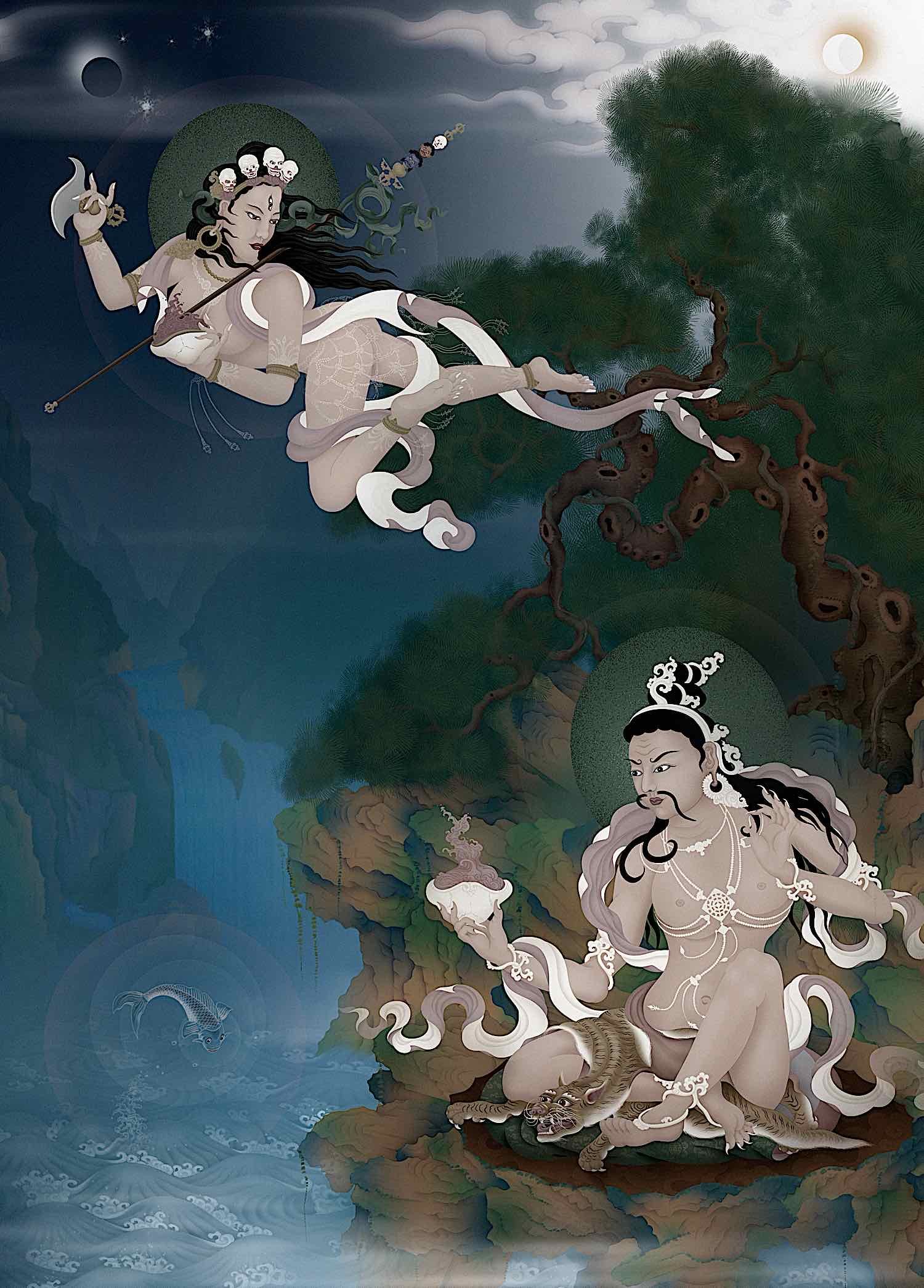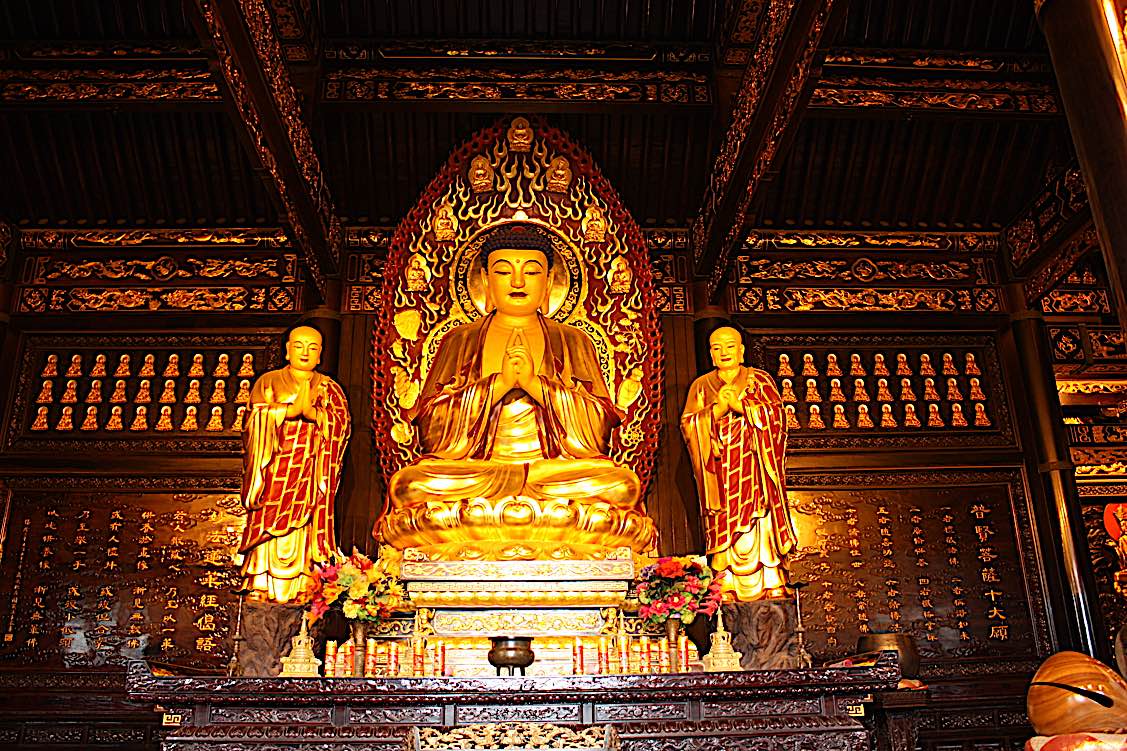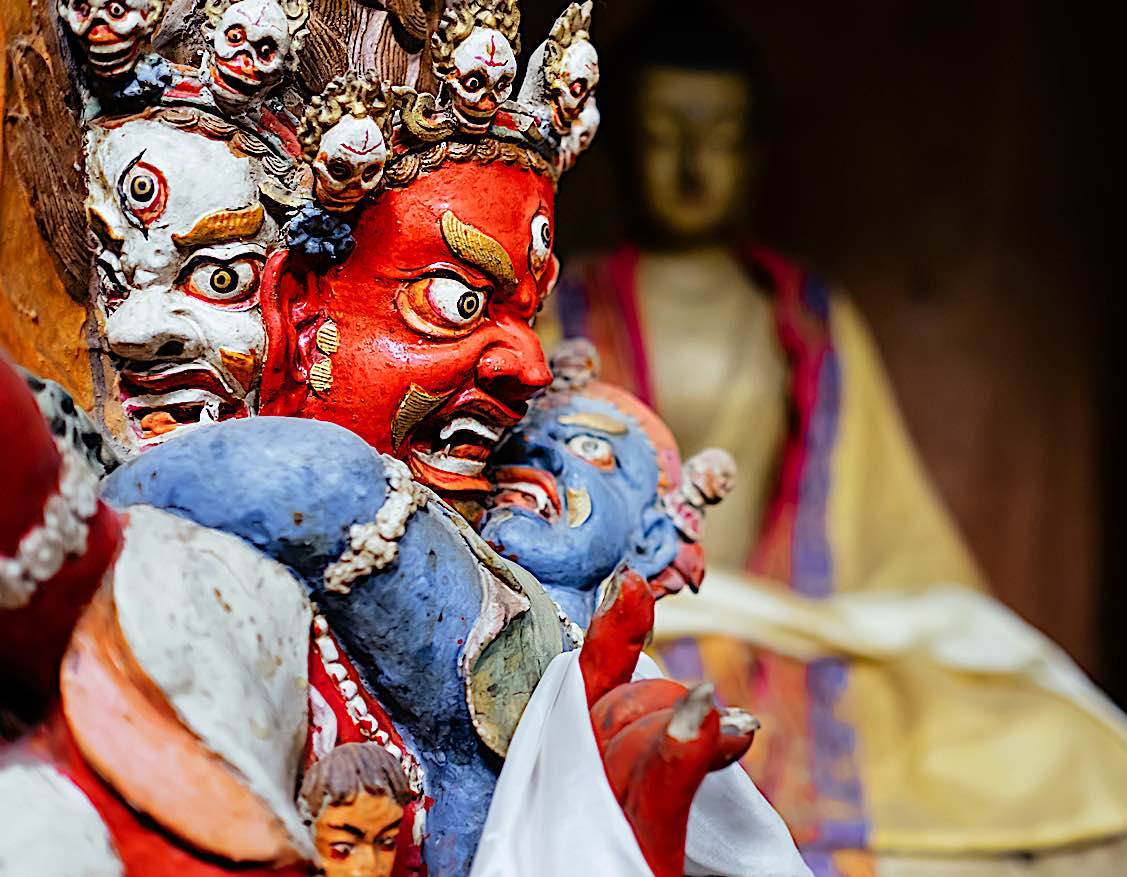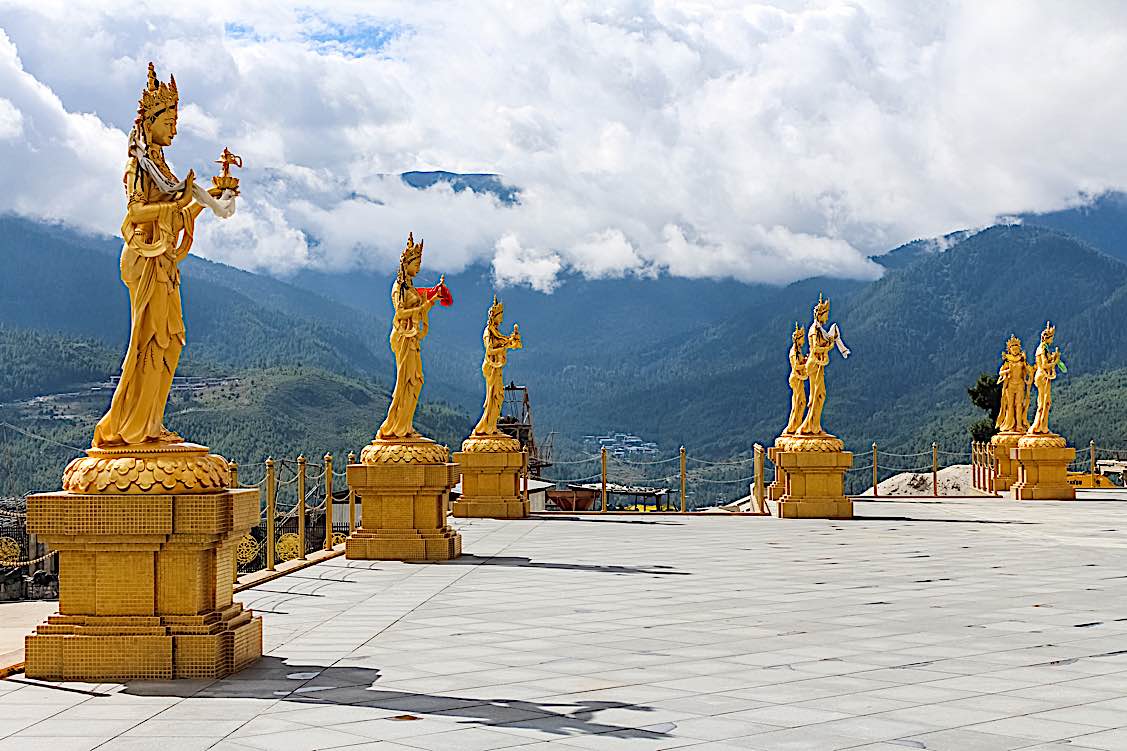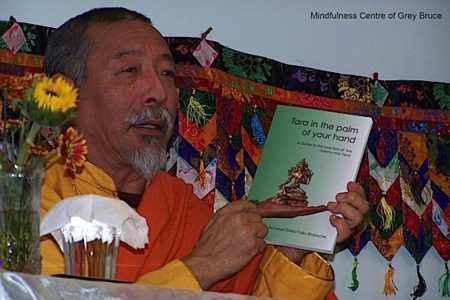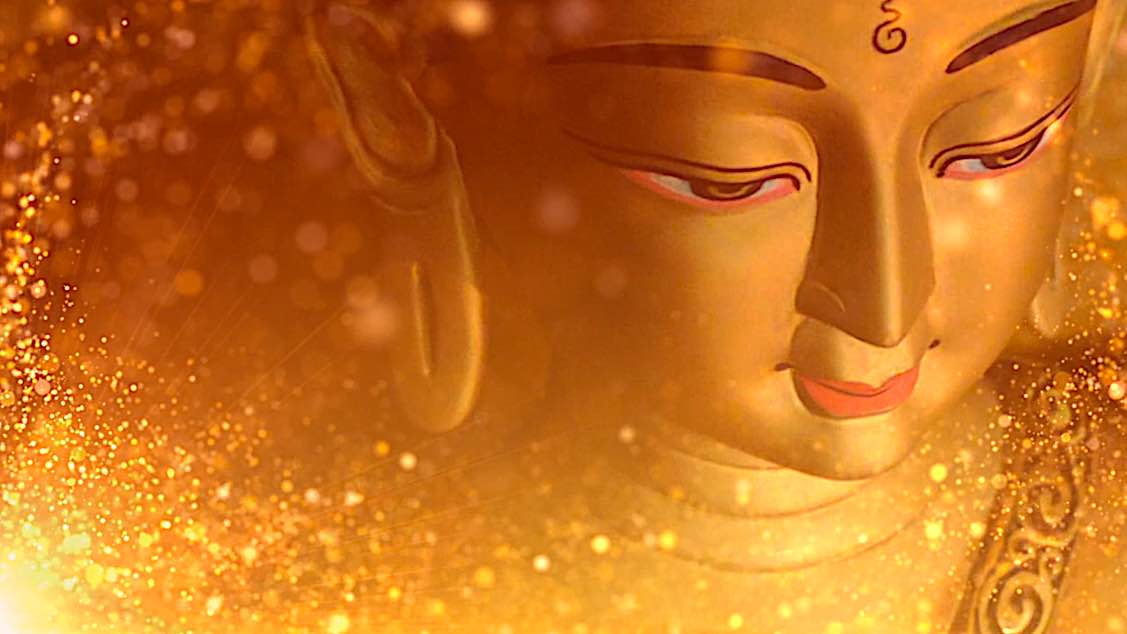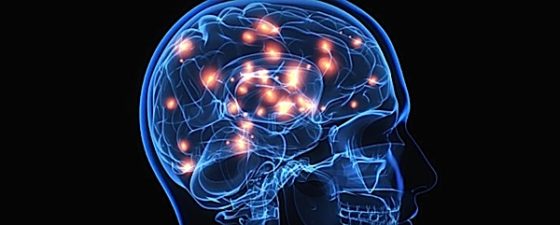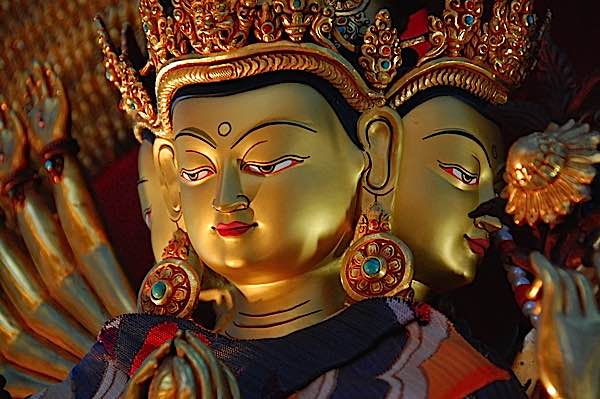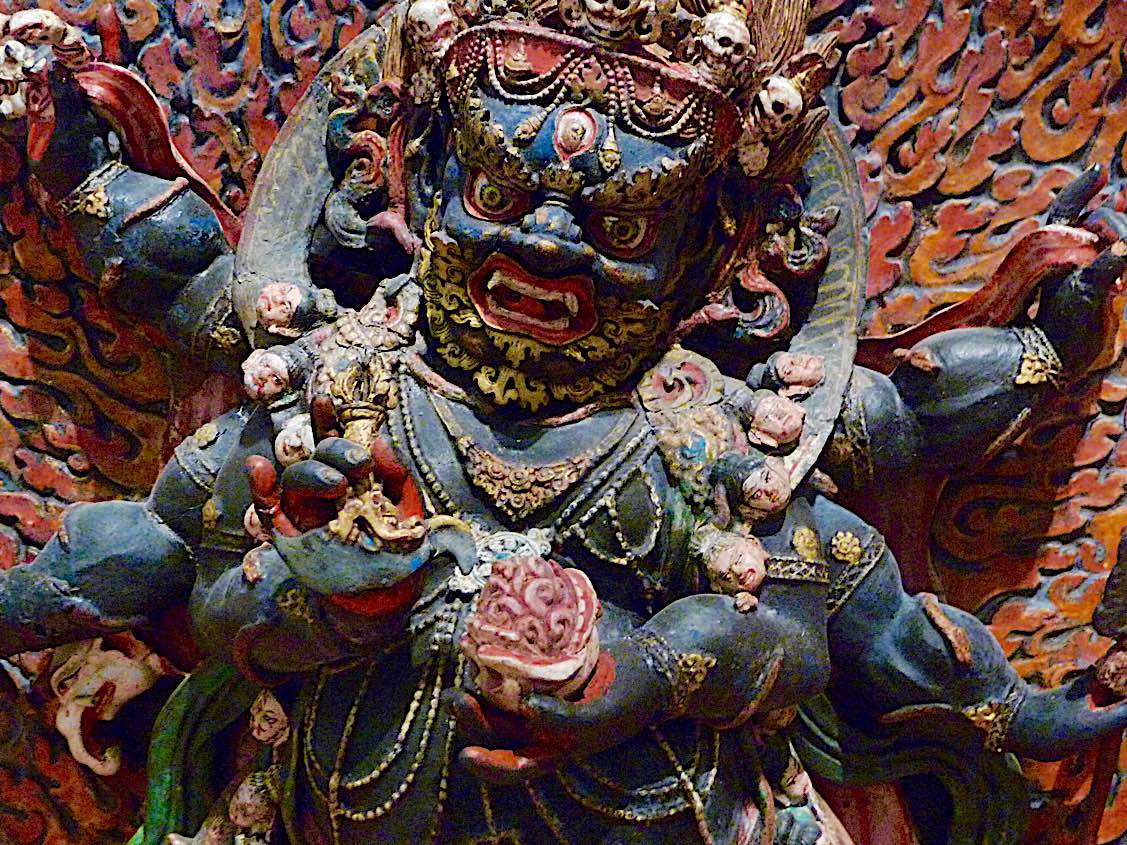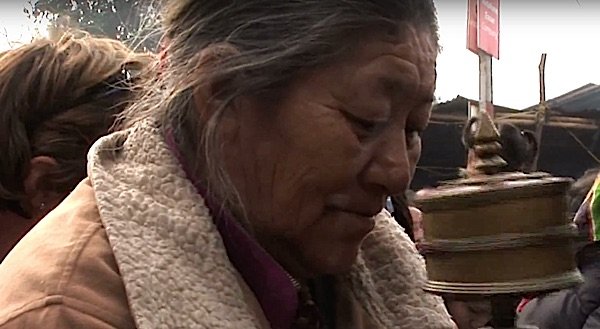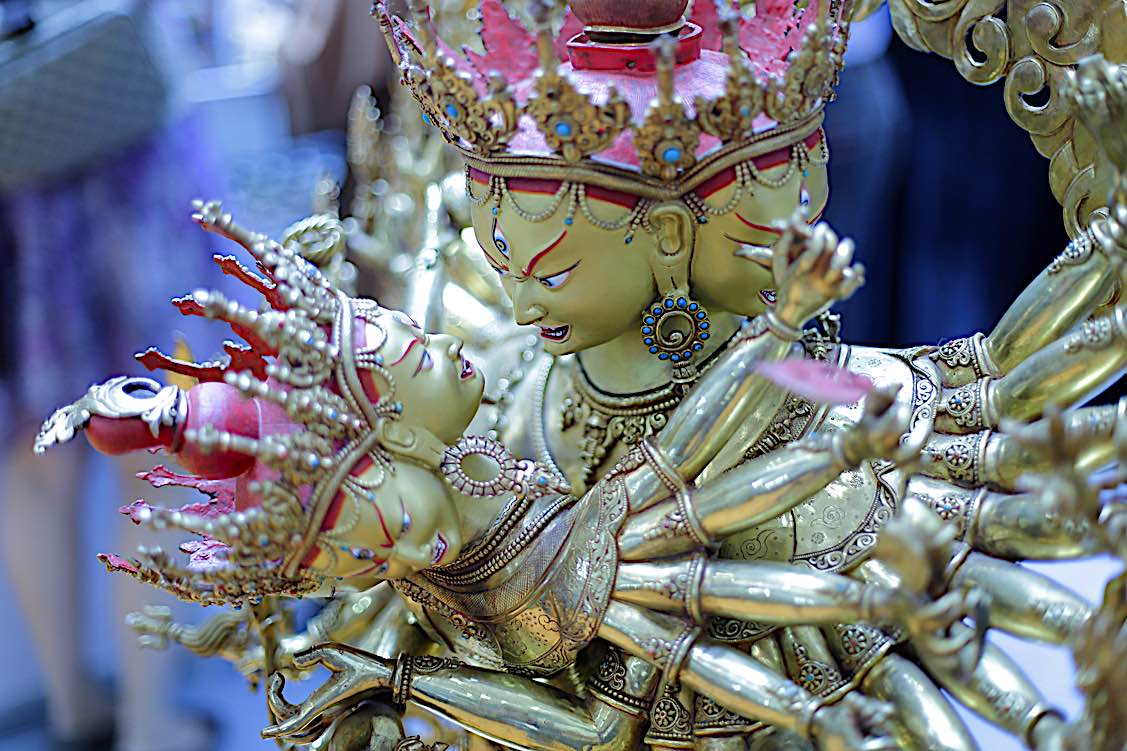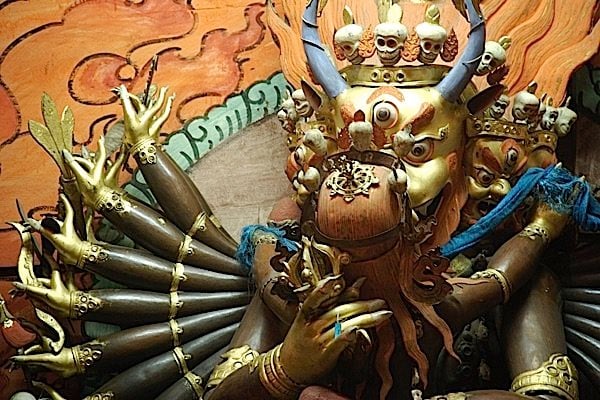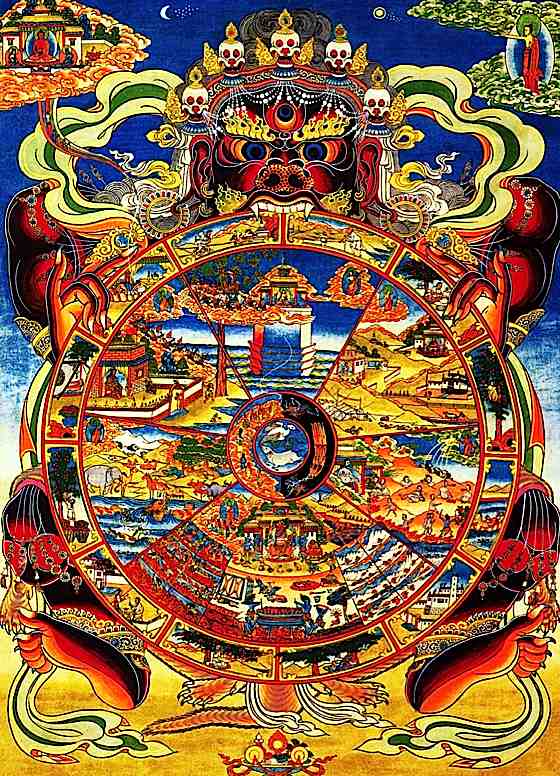[ad_1]
Are Buddhas, Bodhisattvas, Yidams, and Deities real in the same relative way that we exist? Are they other? Are they neither? What do the Buddhist teachers tell us? What can we learn about this from Sutra? In this feature we explore the reality of Buddhist meditation deities, taking into account both a devotional Buddhist point of view and a more “mundane” meditational perspective.
In Vajrayana and Mahayana, we accept multiple Buddhas and deities — not only the historical Buddha. To some Westerners, the only way to accept this view is with rationalizations such as, “Deities are mind-constructs”, they are “archetypes and symbols given form”, or “Deities are our own Buddha Nature,” and so on. Or, the ultimate rationalist might just label them “fairy tales” or imagination. While there’s truth in all of these labels, these definitions miss out on the true nature of deities — and the true nature of those “labels.”
How do Buddhist Deities Exist?
“… Buddhas exist in the same way that all phenomenon exist,” explains H.E. Zasep Rinpoche in his popular book Tara in the palm of your hand. “Not inherently, but as dependent-related phenomena, arising from causes and conditions, name, parts, and imputation by mind.”
Stunning thangka detail of Tilopa visualizing a flying Dakini Enlightened deity, from the great artist Jampay Dorje (Ben Christian.) In what way should we view these deities? As visualized aspects of something greater beyond our perception? As pure visualization? As actual deities we see with our own eyes?
“They protect you and bless you”
His Holiness Sakya Trizin explains why deities should also be seen as relatively real, able to bless and help us:
“In Buddhist tradition, we have two truths: the relative truth and absolute truth. In absolute truth, there’s no deity. There’s nothing. It’s inexpressible. In other words, it is something that is completely beyond our present way of thinking and being. But relatively, we have everything existing. We have “I,” and “you,” and all this. Empty it is, also. All these deities are different, with different categories. Some deities are called yidams, some deities are called dharmapalas. It is not just an idea that we have created. They are all truly like this. They protect you and they bless you, they help you…” [4]
Dog’s tooth or Buddha’s tooth: faith makes the difference
H.E. Zasep Rinpoche, in the book Tara in the palm of your hand, recounts a famous story: “about an old woman and her son, also speaks to the importance of faith. A man was about to make a pilgrimage to see some relics of Buddha; his old mother, who was very devout, asked him to bring back one of Buddha’s teeth. The man promised, and then promptly forgot. As he was returning home from his pilgrimage, he remembered his promise about the Buddha’s tooth. What to do? He quickly found an old dog’s tooth, and wrapped it in silk. When he arrived home, he gave the dog’s tooth to his mother, telling her it was the Buddha’s tooth. His delighted mother put the tooth on her shrine, and began doing prostrations to it. To the man’s amazement, the tooth began emanating light, just as a genuine relic might. The woman’s deep faith had brought about this miraculous event.”
Buddha deities in temples are not simply about devotion, although we show our devotion and faith by making offerings to them — which is for the purpose of creating positive karma or merit in our life.
Tibetan Buddhists understand the true nature of deities, just as they understand the true mind-nature of “pure lands.”
His Eminence Jamgon Kongtrul Rinpoche (the 3rd) explains it this way: “What is the correct view? Knowing that relative appearances and their ultimate reality are inseparable and not contradictory.”[3]
Some deities are highly wrathful, drawing on universally understood symbolism.
H.E. Zasep Rinpoche, elaborates:
“Indeed, even in the West, it is commonly acknowledged that if we believe something to be true, it is true for us. The mind is such a powerful instrument that faith can bring worlds into being. Faith expands reality… When you have faith… you will receive profound blessings, blessings that come ultimately not from somewhere or something outside yourself, but from your own compassion and wisdom, from your own Buddha Nature being actualized.” [From Tara in the palm of your hand.]
Where are deities?
Famously, when John Blofeld — whose many books helped introduced Buddhism to the west — asked a poor Tibetan woman where were the purelands, the woman pointed at her heart. If you asked her where were the deities, she might make the same gesture. Of course, in Tibetan Buddhism, the heart is the location of mind (not the brain). She was referring, specifically, to the old Buddhist concept: “deities are mind.”
The great teacher Lama Thubten Yeshe described deities very precisely: “Tantric meditational deities should not be confused with what different mythologies and religions might mean when they speak of gods and goddesses. Here, the deity we choose to identify with represents the essential qualities of the fully awakened experience latent within
Lama Yeshe.
us. To use the language of psychology, such a deity is an archetype of our own deepest nature, our most profound level of consciousness. In tantra we focus our attention on such an archetypal image and identify with it in order to arouse the deepest, most profound aspects of our being and bring them into our present reality.” (Introduction to Tantra: A Vision of Totality [1987])
Also important to understanding deities is the nature of deities. Do we “conjur” these gods to then bow down and worship them? No, in Vajrayana, we take them into ourselves (it’s called absorbing the deity) — and in advanced yogic practice we self-generate as the deity. We visualize ourselves as the deity, then we see ourselves dissolve to Emptiness. Why work so hard making deity seems real, if we are only going to dissolve back into emptiness? After all, these visualizations are beyond challenging. Why, then, give them up after all that hard work?
Buddhist deity representations can appear different in various Buddhist traditions, but they represent the same concepts.
More than Archetypes
Venerable Zasep Rinpoche teaching at a Tara weekend using the commentary book, Tara in the Palm of Your Hand, as a reference.
What are archetypes, but visual labels (symbols)? Since the language of the mind — particularly sub conscious mind — is visual (symbol), archetypes are just another form of label, like “I” is a label for ourselves. If I label a deity Avalokiteshvara, I am labeling the compassion of the Enlightened Mind.
Tibetan Buddhists, in fact, are highly advanced thinkers in the area of mind. “For Tibetan Buddhists, and those who truly understand Shunyata and dependent arising, reality has room for Buddhas and other manifestations of spiritual energy,” Venerable Zasep Rinpoche explained. “For them, Buddhas are always present; no place exists where there is no Buddha.”
For this reason, we often see highly respected Lamas — including the Dalai Lama — worshipping in a Cathedral, or a Hindu temple. This is not just out of respect for another view; it is acceptance that, once labeled, those deities have dependently arisen — much as our own egos arose, conditioned on surrounding causes — at least in our minds. And — in Tibetan Buddhism — mind is the essence.
All Buddhas are One Essence
Ultimately, all Buddhas are of One Essence. (Or, one taste, as the Dharma texts put it.) Just as we, ourselves are one with all — our very existence depends on others. Without others, we don’t exist, or as the cognitive scientist Professor Hoffman puts it:
“I call it conscious realism: Objective reality is just conscious agents, just points of view. Interestingly, I can take two conscious agents and have them interact, and the mathematical structure of that interaction also satisfies the definition of a conscious agent. This mathematics is telling me something. I can take two minds, and they can generate a new, unified single mind.” [2]
When we visualize Buddhas and deities in Tibetan Buddhism we see them as “the nature of light and energy”.
Once mind labels a spiritual energy, it is as real as our own egos — the nature of “I”. The same Lamrim logic debate used to deconstruct “I” — the famous “where is I, anyway” debate — can be applied to deities.
Emptiness of Deities is the same as Emptiness of self
In an extensive weekend teaching on Mahamudra, H.E. Zasep Rinpoche described it breifly this way:
Where exactly is the “I” that we call our selves? Is it our brain? Our brain activity? Our mind (and if so, what is our mind?). Our body? Which part of our body? The body is made up of billions of cells. When you hunt for the location of the “I” in an analytical way, it is difficult to find.
“I look at my body, and ask myself the question, what is my body? … You do a scanning meditation and try to find your body. When you scan your skin, you ask, is that my body? No, it’s skin, not body. Then you look at your bones, and likewise every part of your body.” If you scrutinize the body this way you’ll find body parts, but not body. Even those body parts have components if you scan those body parts. “To be body, it has to be the ‘whole’ body, all the parts. If you really look, you can’t find one thing that is your body. What we call body is just a ‘label’. A name. Imputing a label.” Therefore, “yes it’s a body” in relative truth, “but when you search for the absolute body, you can’t find it. We can call this the emptiness of our body.” It only exists by virtue of it’s label.
You can, Rinpoche added, apply this logic to a car: “A good example is your car. If you take that car apart, and everything is just parts, there is no car. Just car parts. You put it back together, and then label it Hyundai, you have a Hyundai. But if you switch the labels [to Honda] is it now a Honda? It’s all labels. There is no independent existence. That’s only one way to look at emptiness.”
The same debate can be made with deities. Where is Avalokiteshvara (Guanyin)? Is he the nature of light? Is he the nature of mind? Is he this statue? Is he in my heart? Is he in my brain? Is he in this Dharma text? Is he everywhere? Is he anywhere there is a compassionate act? Avalokiteshvara is just as real as “I” — which ultimately means, empty. Yet, does that mean Avaolokiteshvara is not real? No more than we are not real. At the relative level you can point to “components” of (Avalokiteshvara) (or of I) but you can never really find one thing that is him (or I).
The faces of Chenrezig’s compassion. Chenrezig is known as Avalokiteshvara in Sanskrit, Guanyin and Kanon in Chinese and Japanese.
In this debate, there is no valid reason to dismiss “Tara” or “Chenrezig” as non-existent. Both “I” and Tara are empty, ultimately, of inherent existence. They only exist dependent on others. Deity, from this point of view, can be argued to be as real as “I”.
Some deities are wrathful, symbolism a certain energetic quality.
Is faith important? The story of “Eating stones”
In Tara in the palm of your hand, Rinpoche explains: “There is a story in the Lamrim, the Graduated Path to Enlightenment, about the power of faith. It was a time of famine in India, and many people were dying. An old woman went to her Guru and asked how she could stay alive. He told her to eat stones, and gave her a mantra to make the stones edible. The woman recited the mantra with great faith, and ate the stones. Her son, who was a monk, began to worry about his mother, and went home from his monastery to see her. He was amazed to find her well. When he asked her the secret, she told him the mantra she had been reciting. The son realized that his mother had not been reciting the mantra accurately, and gave her the correct mantra. However, the old woman lost faith in the power of her mantra, and neither it nor the correct mantra would work anymore. It is not the words themselves that give mantras their power; it is the faith with which the words are recited.”
Faith makes the prayer wheel go around. A Tibetan spinning a hefty traditional prayer wheel. Typically, a session would be for tens of thousands of recited mantras.
The old woman’s dog tooth in the earlier story emanated light because of her faith in what it represented — the Enlightened Buddha. Also, ultimately, the dog’s tooth is also one with Buddha’s tooth. Why bow down to a statue of bronze, which clearly is not Tara? To a Vajrayana Buddhist it is indeed Tara. Tara is everywhere. In her statue, quietly sitting on our shrine, we have a focus (or in our mind-visualization) — and that focus represents the truth of Tara (or Chenrezig, Yamantaka or any other deity).
Cultural obstacles to “faith”
Western Buddhists who approach Vajrayana or Tibetan Buddhism might be at a disadvantage when it comes to accepting, with faith, Buddhist deities. It’s one thing to rationalize ultimate truth and relative truth and dependent arising — but if we grew up in a culture devoid of Buddhas, faith will not be culturally reinforced. The deities visualized in Tantra are somewhat “alien” to the Western practitioner — at least until the symbolism of the deities is explained. Implements in the hands mean something. ” A “sword” is knowledge. A skullcup full of nectar is “bliss.” Using the language of the mind, we are taught to visualize deities.
Some deities, particularly Higher Tantric deities, can be easily misunderstood — especially in the west where we tend towards being highly literal. This is why, in Tibetan Buddhism a teacher is needed.
The late Gelek Rimpoche, once said, “There’s no reason Tara can’t appear as Yamantaka.” In other words, on one level, we don’t have faith in Tara as a tangible green goddess who only saves people from the great fears. We have faith that she is Buddha, that all Buddhas have the same realizations, that we are one with Buddhas, that She is one with us — and also with Yamantaka. Also, as taught in the Heart Sutra, “Form is emptiness, emptiness is form.”
Third Jamgon Kongtrul Rinpoche.
H.E. Jamgon Kongtrul Rinapoche the Third wrote: “Why are there so many? Yidams are visualized pure forms that manifest from dharmadhatu’s empty essence as the lucid self-display of our Lama’s compassion.” The goal of Yidam practice is critical to understanding these forms: ” What is the purpose of Vajrayana practice? Purifying one’s impure perception of all appearances and experiences.” [3]
How to relate to deities?
Deities in Buddhism are no to be thought of as self-aware ego-centric magical beings. They are aspects of Enlightenment. They are derived — as are we all — of a reality where only egos and attachments separate us. Remove the ego, and we become one with the universe. The last thing a Buddha should be associated with is ego.
Then, how do we associate them. To us, because we do have egos and cultural imprints and attachments and obstacles, they appear in various forms. Famously, in Tibet, Manjushri, the gentle Buddha of Wisdom appeared as monstrous bull-headed Yamantaka. Why this form? Because Tibetans could believe that such a fierce form could subdue the death itself — Yama.
Yamantaka, the foe-destroyer of death.
The Enlightened forms are given to us by long lines of great accomplished masters — lineage, as it’s called. Because we know these great teachers accomplished realizations, we follow their examples — which includes visualizations of deities in forms that are symbolically profound. These “images” resonate with our subconscious, but also with cultural memory, or — as Psychiatrist Carl Jung put it — the collective consciousness.
Red means something to the collective consciousness. A “red” deity magnetizes. This isn’t a “taught” symbol. They are discovered, common, collective symbols we all share.
How can we all share the same response to “red”? Because, ultimately, we are one — if we remove the ego that traps us in samsara.
This tanka illustrates the Wheel of Samsara, also called Cycle of Existence, Path of Transmigration, Wheel of Life. The wheel can also be thought of as an illustration of karmic consequences and the actions of karma. Ego leads to clinging, clinging leads to suffering, suffering leads to more suffering, and the cycle remains unbroken unless we follow the eight-fold path of Buddha. On the night of Shakyamuni’s own enlightenment He saw all his past lives, countless lives of suffering stretching back and (and possibly forward in time, since time is often thought of as cyclic in nature itself). The wheel is thought of by some as metaphoric, illustrating as it does the six realms: hell realm at the bottom, animal realm, human realm, heaven realm, hungry ghost realm, Asura realm. Even if one rises, through positive kara to more “enjoyable realms” such as heaven, the suffering continues as we cling to the beauty of this realm. Ultimately, even the most lofty of rebirths leads back through the cycle of suffering until enlightenment is achieved. Some believe the wheel to be more literal, although understood, at an ultimate level as empty. When we speak of liberation in Buddhism, we refer to freedom from the Wheel of Suffering.
NOTES
[1] [1] Max Planck, 1944; Das Wesen der Materie [The Nature of Matter], speech at Florence, Italy (1944) (from Archiv zur Geschichte der Max-Planck-Gesellschaft, Abt. Va, Rep. 11 Planck, Nr. 1797)
[2] “The Case Against Reality”, The Atlantic
[3] “The Three Roots: The Lama, Yidams and Protectors” His Eminence Jamgon Kongtrul Rinpoche the Third, Karma Lodrö Chökyi Sen
[5] Interview with HH. Sakya Trizin on Tricycle.
[ad_2]
